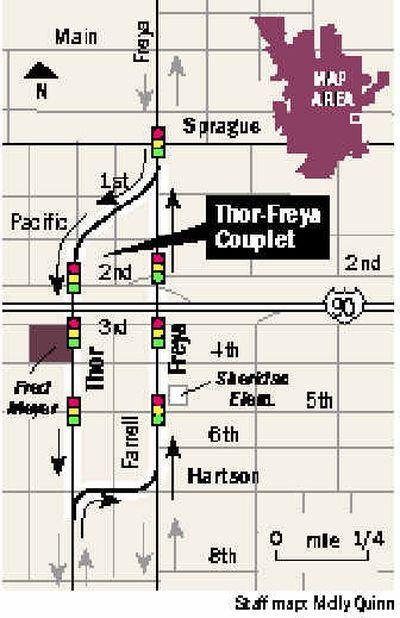New couplet

A plan to convert Thor and Freya streets into one-way arterials through the East Central Neighborhood is expected to improve pedestrian and vehicle safety, but the project hasn’t been universally accepted by nearby residents. The Spokane City Council last week approved a low bid by Spokane Rock Products Inc. and authorized a contract for the work. Work is expected to begin this spring.
The contract amount of $3.36 million does not include engineering or real estate costs. Federal grants are being used to pay for much of the work.
The project involves converting Thor Street into a one-way southbound and Freya Street into a one-way northbound from Sprague Avenue on the north to Hartson Avenue on the south. New curbs, traffic lights, pavement resurfacing and striping are included.
Northbound traffic will cross from Thor to Freya streets in a newly built, curving section of roadway at Hartson Avenue. Freya Street south of Hartson will connect to the new one-way at a stop sign
Traffic officials said pedestrians as well as drivers will have an easier time crossing the busy arterials because vehicles will be coming in one direction instead of two. Traffic flow will be improved because of elimination of left-hand turns against opposing traffic.
“On the whole, I think it will improve life in that area,” said Eric Johnson, the former chair of the East Central Neighborhood Council.
The drive for the project dates back at least a decade, Johnson said, but it became a priority in 1999 after two girls were hit by vehicles in accidents a few months apart.
One of the girls was nearly killed after getting off a bus at Thor Street. She underwent a long recovery from a head injury.
The other girl was hurt while hurrying across Freya Street, late for class at Sheridan Elementary School.
Not all area residents are in favor of the project.
Johnson said about half of the residents living between Thor and Freya streets in the area of the planned one-ways were opposed, in part because it will create more traffic on their residential streets from motorists going back and forth between the two one-ways.
Sharon Daggett sought to organize a group of residents against the project, but they failed to persuade the East Central Neighborhood Council to reverse its support.
Daggett, who lives in the South Altamont area, said “couplet” arterial arrangements create barriers in neighborhoods and force residents to use cars instead of their feet to get to shops and services. Urban neighborhoods are damaged by high traffic, she said.
A couplet is an engineering term for two one-way arterials. Examples include the Ash-Maple and Division-Ruby corridors.
“They are backwards,” Daggett said. “It makes livability go down.”
The traffic improvements will allow drivers to go faster, and the arterials will act as walls partitioning off portions of the neighborhood, she said.
East Central already has been damaged by the existence of Interstate 90 through the heart of it, and it will be further damaged if and when the state builds a huge expansion of the freeway and collector streets near Second and Third avenues.
The freeway expansion is planned in conjunction with the North Spokane freeway, which is proposed to connect with I-90 in the East Central Neighborhood.
Work on the Thor-Freya project is expected to begin in April or May, said Tom Arnold, director of engineering services for the city.
The proposed contract would allow Spokane Rock Products 18 weeks to complete the project.
Steve Chandler, project engineer for J-U-B Engineers Inc., Spokane, said Thor and Freya each will have three lanes with new curbs and sidewalks, which will be set back with buffer strips. The intersection of Second Avenue and Freya Street, which handles traffic exiting I-90, will be redesigned to improve safety, he said.
Traffic lights will be equipped with video cameras to monitor and control traffic throughout the day, he said.
Designers had considered extending curbs at crosswalks to shorten crossing distances for pedestrians, Chandler said. However, that idea was rejected because it would have slowed plowing in the winter.
Jerry Numbers, chair of the East Central Neighborhood Council, said the neighborhood has been working with Eastern Washington University and college students to devise a new land-use plan for much of East Central. It would include a new mixed-use designation for parcels between the two arterials. That would give existing property owners more options for future uses of their land, Numbers said.